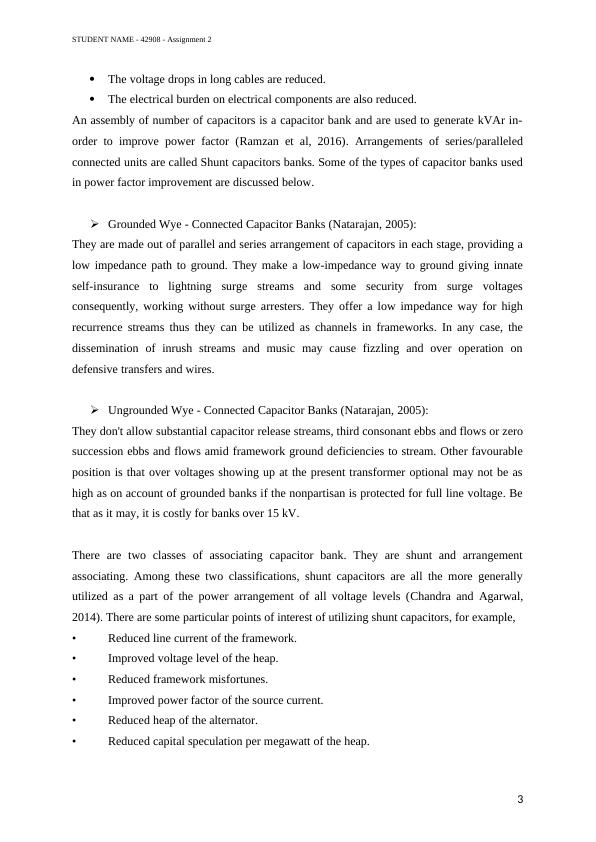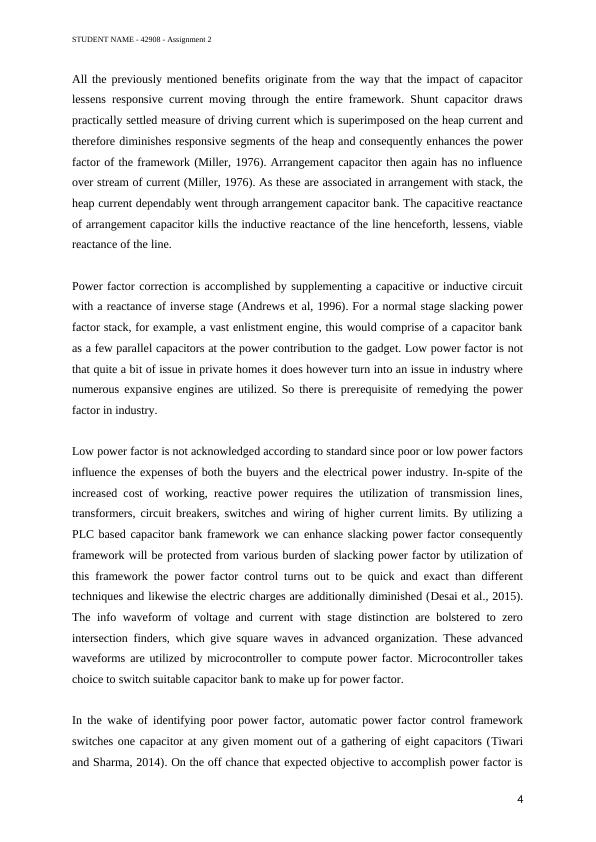Power Factor Improvement Through Capacitor Bank - Desklib
Added on 2020-03-28
12 Pages4778 Words296 Views
STUDENT NAME - 42908 - Assignment 2Power Factor Improvement Through Capacitor BankBy ‘Author Name’Affiliation (MSc Profile or Track) & Study noAbstractThis paper intends to critically assess the use of capacitor bank in improving the power factorof electrical systems. The main objective of the paper is to assess the power loss due to lowpower factor and the application of capacitor bank as a way to reduce power loss byimproving the power factor of the system. The performance of electrical power systems isseriously affected by reduction in power factor because a reduced power factor increases theline losses to a great extent. The increased losses not only reduce the efficiency of a powersystem but also increases the operation cost of the power system. The reduction in powerfactor is due to the fact that most of the line loads connected in a power system is inductive innature and inductive loads are known to reduce the power factor. Capacitor banks are used toimprove the power factor reduced by inductive loads for decades and this paper discusses thepower factor improvements achieved by using capacitor banks.1. IntroductionAn AC system is made up of a lot of components and based on their load consuming naturethey can be classified as capacitive, resistive and inductive. In case of purely resistive loadthe current and voltage are in phase but most of the loads connected in any facility isinductive in nature and in case of inductive loads the current lags the voltage and is thereforeout of phase whereas, in case of capacitive load the current leads the voltage (Stokes, 2008).The current which is leading or lagging the voltage is called wattles current because itsupplies reactive power and this power is essential for turning motors attached to the ACsystem (Stokes, 2008). So this type of load cannot be avoided and if this type of loadincreases then the reactive power requirement increases which in-turn increases the kVAdemand for the same kW load (Stokes, 2008). Most of the high tension tariff charge aseparate kVA charge along with the kW charges which increases the electricity bill of theconsumer (Stokes, 2008). Thus consumers having low power factor have to pay more for theuseful power they use making power factor improvement a necessity.1

STUDENT NAME - 42908 - Assignment 2Some of the methods applied to improve power factor in a system are as follows:Capacitive power factor improvement could be easily implemented as they arecapable of supplying the reactive power required by the load by connecting thecapacitor bank in parallel to the inductive load (Turchi et al., 2014). The capacitorbank acts like a source of reactive power and thus the inductive load absorbs lowerreactive power from the AC system thus reducing the phase difference between thecurrent and voltage.Power factor improvement using Synchronous Condenser is another method where athree phase overexcited synchronous motor working under no load is connected to theload side of the inductive load (Turchi et al, 2014). Synchronous condenser functionslike a capacitor by either supplying reactive power or by drawing lagging currentfrom the AC supply.Phase advancer is an AC exciter which could improve the power factor of inductionmotor (Turchi et al., 2014). It is connected to the rotor circuit of the induction motorand is mounted on the shaft of the induction motor (Turchi et al., 2014). The fluxrequired a slip frequency needs exciting ampere turns and the phase advancer suppliesthis ampere turn and thus improves the power factor.As seen above most of the methods stated above work similar to a capacitor so as to improvethe power factor and therefore capacitor banks are mostly used in power factor improvement.Another advantage of using capacitors in power factor improvement is that they are readilyavailable in different sizes and shapes and are cheaper than other methods used to improvepower factor. Therefore, capacitor banks are widely used in the application of power factorimprovement. This papers briefly reviews the work carried out in improving the power factorusing capacitor banks.2. Literature ReviewImprovement in power factor has certain advantages as follows (Natarajan, 2005):As energy efficiency improves the power consumption reduces which results inreduced fossil fuel usage and greenhouse gas emissions form the power stations.Electricity bills are reduced.The existing supply can deliver more kVA.Losses in distribution equipment and transformers are reduced.2

STUDENT NAME - 42908 - Assignment 2The voltage drops in long cables are reduced. The electrical burden on electrical components are also reduced. An assembly of number of capacitors is a capacitor bank and are used to generate kVAr in-order to improve power factor (Ramzan et al, 2016). Arrangements of series/paralleledconnected units are called Shunt capacitors banks. Some of the types of capacitor banks usedin power factor improvement are discussed below.Grounded Wye - Connected Capacitor Banks (Natarajan, 2005): They are made out of parallel and series arrangement of capacitors in each stage, providing alow impedance path to ground. They make a low-impedance way to ground giving innateself-insurance to lightning surge streams and some security from surge voltagesconsequently, working without surge arresters. They offer a low impedance way for highrecurrence streams thus they can be utilized as channels in frameworks. In any case, thedissemination of inrush streams and music may cause fizzling and over operation ondefensive transfers and wires. Ungrounded Wye - Connected Capacitor Banks (Natarajan, 2005):They don't allow substantial capacitor release streams, third consonant ebbs and flows or zerosuccession ebbs and flows amid framework ground deficiencies to stream. Other favourableposition is that over voltages showing up at the present transformer optional may not be ashigh as on account of grounded banks if the nonpartisan is protected for full line voltage. Bethat as it may, it is costly for banks over 15 kV. There are two classes of associating capacitor bank. They are shunt and arrangementassociating. Among these two classifications, shunt capacitors are all the more generallyutilized as a part of the power arrangement of all voltage levels (Chandra and Agarwal,2014). There are some particular points of interest of utilizing shunt capacitors, for example, •Reduced line current of the framework. •Improved voltage level of the heap. •Reduced framework misfortunes. •Improved power factor of the source current. •Reduced heap of the alternator. •Reduced capital speculation per megawatt of the heap. 3

STUDENT NAME - 42908 - Assignment 2All the previously mentioned benefits originate from the way that the impact of capacitorlessens responsive current moving through the entire framework. Shunt capacitor drawspractically settled measure of driving current which is superimposed on the heap current andtherefore diminishes responsive segments of the heap and consequently enhances the powerfactor of the framework (Miller, 1976). Arrangement capacitor then again has no influenceover stream of current (Miller, 1976). As these are associated in arrangement with stack, theheap current dependably went through arrangement capacitor bank. The capacitive reactanceof arrangement capacitor kills the inductive reactance of the line henceforth, lessens, viablereactance of the line. Power factor correction is accomplished by supplementing a capacitive or inductive circuitwith a reactance of inverse stage (Andrews et al, 1996). For a normal stage slacking powerfactor stack, for example, a vast enlistment engine, this would comprise of a capacitor bankas a few parallel capacitors at the power contribution to the gadget. Low power factor is notthat quite a bit of issue in private homes it does however turn into an issue in industry wherenumerous expansive engines are utilized. So there is prerequisite of remedying the powerfactor in industry. Low power factor is not acknowledged according to standard since poor or low power factorsinfluence the expenses of both the buyers and the electrical power industry. In-spite of theincreased cost of working, reactive power requires the utilization of transmission lines,transformers, circuit breakers, switches and wiring of higher current limits. By utilizing aPLC based capacitor bank framework we can enhance slacking power factor consequentlyframework will be protected from various burden of slacking power factor by utilization ofthis framework the power factor control turns out to be quick and exact than differenttechniques and likewise the electric charges are additionally diminished (Desai et al., 2015).The info waveform of voltage and current with stage distinction are bolstered to zerointersection finders, which give square waves in advanced organization. These advancedwaveforms are utilized by microcontroller to compute power factor. Microcontroller takeschoice to switch suitable capacitor bank to make up for power factor. In the wake of identifying poor power factor, automatic power factor control frameworkswitches one capacitor at any given moment out of a gathering of eight capacitors (Tiwariand Sharma, 2014). On the off chance that expected objective to accomplish power factor is4

End of preview
Want to access all the pages? Upload your documents or become a member.
Related Documents
Power Factor Correction in RLC Circuit | Assignmentlg...
|3
|687
|24
Static Synchronous Compensator (STATCOM) for Voltage Compensation of AC Transmission Lineslg...
|3
|950
|463
Synchronous Generator and Short Transmission Line Circuit Analysislg...
|10
|697
|73
AC TRANSMISSION LINES.lg...
|3
|468
|1
Voltage Compensation for AC Transmission Lineslg...
|3
|619
|325
Power System Analysis Part 2 .lg...
|16
|1740
|475
